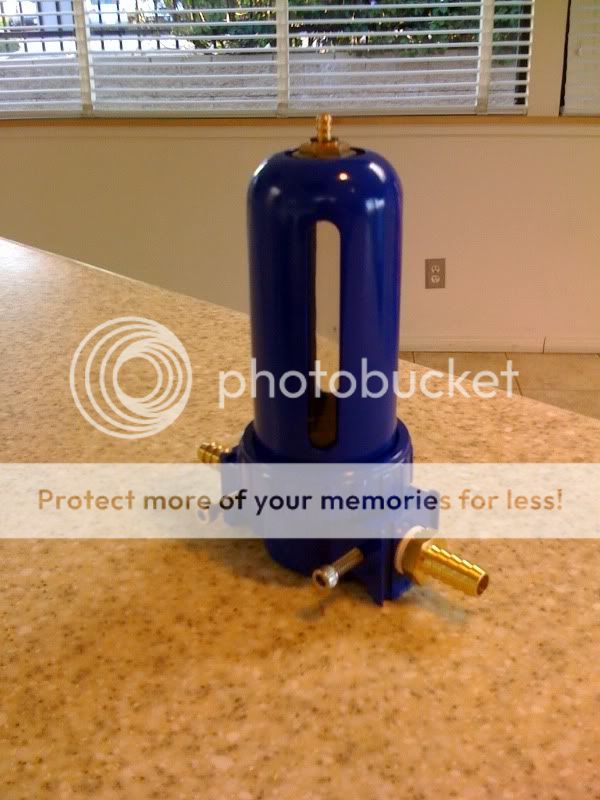Here is what I have found when using a oil separator that is
positive pressure rated. Usually, but not always, there is a beryllium copper filter in the unit. This causes a huge drop in the
vacuum level allowed to pass through the unit. In the past, I have drilled a series of small holes int he filter to reduce the restriction to zero.
This is the basic issue. A filter that is
positive pressure rated is constructed differently than is one that is
partial pressure rated. Not throwing rocks at anyone here but, most folk do not have a good understanding of the differences between the positive and partial pressure handling. Things that work perfectly in a positive pressure environment will fail, utterly, in a partial pressure environment. It is physics at work.
But, one the concept is grasped, the understanding comes nearly instantly. Usually, something like this is enough for most.
If you have a vacuum gauge, it is a simple matter to measure the vacuum at the inlet side of the unit and then the outlet side. The two readings
must match or you will get a very poor result out of the PCV system. Poor as in the possibility of hte rear main seal leaking.
I first used this type of separator . Did not like the results and so replaced it with a Moroso dedicated oil/air separator.
This one, to be exact:
http://www.amazon.com/Moroso-85474-Universal-Air-Separator/dp/B004K9BIY4/ref=sr_1_1?s=automotive&ie=UTF8&qid=1396192175&sr=1-1&keywords=moroso+oil+separator
Nope. Not Cheap.
But then you usually get what you pay for. I liked this particular model best due to the built in drain. I have added some rubber line to the drain fitting so as to be able to drain the unit without the possibility of getting oil in my engine bay. Those that have seen my engine bay can tell you that I am a fanatic when it comes to keeping the bay clean. IMO, it should look as clean as the day it rolled off of the assembly line. Yup, a fanatic for sure...
How I Installed my setup.
Firstly, I took a vacuum reading at the compressor's intake manifold where the PCV system was to connect. I then connected the system. Secondly, the line from the front PCV elbow to the air cleaner was disconnected at the air cleaner end and a reading taken.
These two reading must be the same. If they are not, then the most likely culprit is a plugged orifice in the rear elbow.
Having established that both readings were, in fact, the same, I then installed the separator.
The first one I installed was a "repurposed" compressed air unit and the vacuum at the outlet of the device was zero. The internal filter could not allow the partial pressure to pass. This is when I drilled the series of small holes, high up in the filter media. I kept adding holes until there was not any drop in the vacuum level.
Later, I replaced the "home grown" with a professional built unit. Much better all the way around.
A Quick Note:
The vacuum readings I refer to here are "dead head" readings. The vacuum gauge is plugged into the lines at the connection point.
Using this method is the accepted procedure.
It was using this method that I discovered why ScienceGuyXJ's 4.9 Litre stroker was blowing rear main seals. The vacuum level in the crankcase was abysmally low. This allowed the crankcase to somewhat pressurize blowing out the RMS. What was done was to open up the size of the orifice in the rear elbow allowing for a greater volume of gasses to be moved. One this was accomplished, the crankcase pressure level became to what it should be (i.e. intake manifold pressure) and he stopped replacing the RMS. In fact, teh RMS that was in it and leaking, stopped leaking...
For those that are considering installing Forced Induction, the installation of an oil/air separator is highly recommended by me. And here is why. The PCV system will be working all of the time instead of just part of the time. In a stock engine, the PCV system stops when the intake manifold goes to atmospheric pressure. This is WOT in other words. When a compressor is fitted, the PCV is connected to the compressor intake, not the engine intake. As it is developing the vacuum via the venturi effect, it continues to function at all throttle settings.
I installed my setup due to the amount of oil I found in the Sprintex manifold when I had it off to do the 68mm TB fitment and insulation installation.
After installing the oil/air separator, I was able to increase the amount of spark. Which is to say, that I was able to pull it back less if you follow... The oil in the air had the
net effect of lowering the octane of the fuel. Lower octane means more spark retard under boost. In total, I was able to put one full degree back into the spark map and, of course, the values throughout the map were altered correspondingly.


